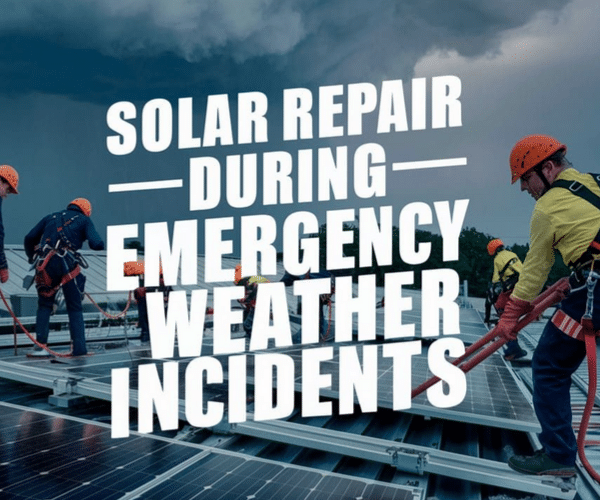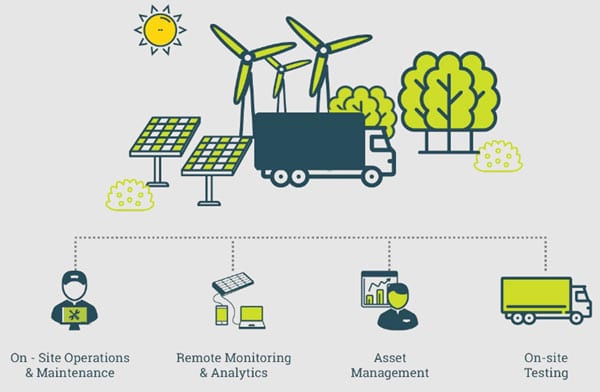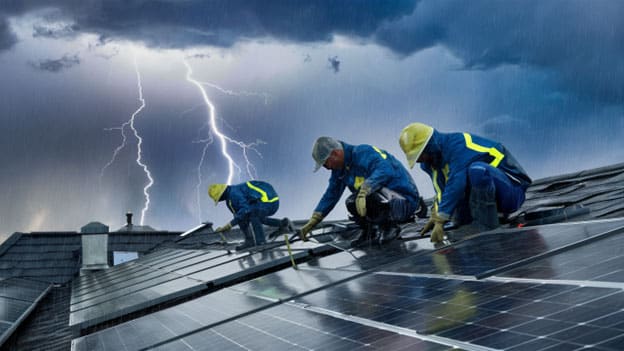
- field service dispatch
- Field Service Management
- Field Service Software
Navigating Solar Repairs Amidst Emergency Weather Incidents
In an era where sustainability sums up the definition of modern living, solar energy systems contribute to the broad global energy solution. However, direct exposure to the elements from these solar panels makes them quite vulnerable to weather emergencies.
Solar repairs from storms, hail, and hurricanes are intense enough to devastatingly hit the solar systems, disrupting energy production and likely having safety repercussions.
This article reviews the management and repair of solar systems in an emergency. It examines vulnerabilities, protective action, rapid response and repair best practices.
With improvements made to their solar panels, stakeholders can mitigate risks and have operations restored quickly. It is not only a matter of hardware; it is about securing the future in renewable energy.
Vulnerability of Solar Panels to Weather-Related Damage
Solar energy systems face significant risks from emergency weather incidents. Understanding solar panels’ vulnerability in harsh conditions and knowing effective protection strategies is critical.
According to a study, “High humidity, rain, and snow significantly affect the efficiencies of PV panels, and bird droppings can create overheated spots on the panel and reduce its output.”
Impact of Weather Extremes
Solar Panels Safety Issues
The most critical safety issue is the structural integrity of the mounting system during violent weather events. If that fails, it could release the panels, turning into dangerous projectiles.
In addition, during heavy rains, water penetration can cause short circuits or even full system failures, which endanger the system and pose a safety risk to residents and emergency responders.
Technological and Material Challenges
The materials and technology used in manufacturing solar panels determine their resiliency. For example, standard panels may resist some winds, but new materials and designs are required to cope with extremes brought about by climate change.
Research into viable materials and robust construction techniques that can endure the unfriendly conditions posed by storms and other weather anomalies is necessary.
Structural improvements, supporting policy frameworks, and community readiness initiatives are part of an inclusive approach to mitigating solar vulnerability during extreme weather events. Proactively meeting these challenges will help build reliability and longevity in solar panel systems while advancing toward a sustainable energy future.
Preventive Measures and Structural Resilience
Key strategies to help enhance the structural resilience of solar installations would mean adopting preventive measures to mitigate the risks involved during severe weather conditions, saving the hardware itself, and ensuring power is not interrupted during critical times.
Designing for Durability
The cornerstone of the preventive strategy is the implementation of robust solar panel safety standards, which define the minimum design requirements for solar panels so they can withstand the stresses in the environment. By adhering to these guidelines, manufacturers can enhance the structural integrity of panels.
Using high-impact-resistant materials and securing panels with more durable mounting systems that are much stronger in high winds and with heavy snow loads.
Solar Panels Safety Precautions
Inspections and checks on maintenance should be done by the solar technician before weather threats like hurricanes or severe storms. These precautions would mean that all the mounting points are securely held. The surfaces of the panels should not have any breakages, while exposed wiring should not hang loose. Protective covers or shields can be fitted to add more safety against flying debris and hail.
Integrated Technology Solutions
Integrating field service management software is pivotal for enhancing responsiveness before and after weather incidents. Solar repair companies can monitor systems from remote areas, predict a potential failure, and dispatch solar panel repair technicians immediately.
FSM software also aids in effectively planning preventive maintenance scheduling and urgent repairs. It helps effectively mobilize resources and reduce downtime.
Preventative and efficient solar repair management integrates regular maintenance practices, weatherproofing techniques, predictive analysis, and energy storage solutions.
Solar Asset Management (source: https://infraon.io/blog/solar-asset-management/)
Rapid Response and Solar Repair Protocols
When emergency weather incidents affect solar energy systems, a speedy and efficient response is needed to minimize downtime and restore functionality, involving well-defined protocols and leveraging advanced technologies to ensure repairs and maintenance get completed in the least time possible.
Immediate Assessment and Response
The first step following a severe weather event is assessing the damage to the solar panels. Qualified solar panel repair technicians can safely identify problems such as cracking, dislodgment, or electrical failure. Timely documentation of damages also helps to plan necessary repairs and expedites the insurance claim process.
Solar Repair Response Innovation Roadmap
Drone-Based Damage Assessment (Rapid aerial surveillance):
Phase 1:
- Deploy initial drone prototypes for field testing.
- Gather and analyze data on operational effectiveness.
Phase 2:
- Refine drone technology based on field test feedback.
- Establish guidelines for drone flight paths and emergency procedures.
Phase 3:
- Scale drone operations to cover larger regions.
- Start integration with AI for automated damage assessment.
Mobile Repair Units (On-the-go repair capabilities):
Phase 1:
- Begin customization of mobile units for tools and parts storage.
- Field test mobile units in controlled environments.
Phase 2:
- Integrate diagnostic tools into mobile units.
- Start small-scale deployment to key regions.
Phase 3:
- Launch fully operational mobile units.
- Develop a feedback loop for continuous improvement.
Structural Reinforcement Technologies (Enhancing panel resilience):
Phase 1:
- Research on advanced materials suitable for solar panels.
- Initiate pilot project for a small-scale solar farm.
Phase 2:
- Finalize and implement reinforcement solutions across test sites.
- Evaluate enhancements against previous performance metrics.
Phase 3:
- Begin mass installation of enhanced structures on new projects.
- Start retrofitting existing installations.
Data and Communication Infrastructure (Ensuring robust information flow during emergencies):
Phase 1:
- Develop data collection frameworks and preliminary communication protocols.
- Test real-time data gathering systems during drone flights.
Phase 2:
- Upgrade communication systems for optimized data transmission.
- Implement end-to-end encrypted communication channels.
Phase 3:
- Finalize robust, scalable communication system for widespread emergency use.
- Test system under simulated emergency conditions.
Training and Guidelines (Empowerment through knowledge)
Phase 1:
- Design initial training modules for drone operation.
- Conduct initial workshops with focus teams.
Phase 2:
- Expand training to include mobile repair unit operation.
- Roll-out community training sessions.
Phase 3:
- Implement a certification program for repair specialists.
- Publish comprehensive guidelines and best practices.
Utilizing Solar Field Service Management Software
Field service management software is critical in organizing and executing a rapid response strategy. This software allows service managers to to track the status of their operations in real-time, allocate resources efficiently, and update service schedule dynamically based on immediate needs.
The ability to quickly dispatch repair teams and provide them with the necessary information about the site conditions and required repairs can significantly reduce response times.
Streamlined Solar Repair Processes
Standardized repair protocols, including solar system repair and commercial solar panel repair, ensure that technicians follow a consistent approach. These protocols include temporary solutions such as applying waterproof sealants to prevent further water ingress or securing loose panels to their mounts.
A total replacement could be necessary for more significant damage, like cracked solar panel repair. The goal is to restore the system to its pre-event condition with as little impact on the client’s operations as possible.
Fast response protocols are crucial for effective solar repair management. By implementing clear emergency shut-off procedures, maintaining prompt communication with emergency services, and training personnel on proper response protocols, organizations can improve their ability to handle solar repair incidents efficiently and minimize disruptions.
Praxedo Field Service Management software and app significantly enhances the efficiency of solar repair processes. By integrating standardized repair protocols for both routine and emergency solar system issues, the app ensures that technicians consistently adhere to best practices. Praxedo can define a step-by-step workflow for each job type that will be presented to the technician within the Mobile Application and will guide him through the process.
Insurance and Financial Considerations
The financial aspects of repairing solar energy systems after emergency weather incidents are significant. Understanding insurance coverage, potential costs, and strategic financial planning is vital for effectively managing solar repair expenses.
Stakeholder Value Proposition Outline
Insurer Value Proposition:
Enhanced risk management and premium adjustment opportunities through resilient solar technologies.
- Customer Goals: Insurers aim to reduce claims costs and frequency by endorsing resilient solar installations that are less likely to be damaged during severe weather events.
- Pains: High financial costs associated with frequent claims and repairs post-disaster, challenging risk assessments due to rapidly changing climate conditions.
- Gains: Improved pricing models reflecting real risks, decreased claims, and enhanced customer satisfaction through proactive support and rapid claims processing.
Technician Value Proposition:
Streamlined, safe and rapid deployment solutions for post-disaster repairs with improved technology.
- Customer Goals: Technicians need efficient workflows, clear protocols, and safe working conditions especially in post-disaster scenarios.
- Pains: Complicated access to damaged sites, high risks during repairs, unpredictable work volume post-disasters.
- Gains: Enhanced job safety, predictable and structured repair protocols, and innovative tools for assessment like drones.
Policy Maker Value Proposition:
Promotion of sustainable and resilient energy policies leading to robust community infrastructure.
- Customer Goals: Policy makers aim to achieve sustainability targets, ensuring public safety and energy reliability during emergencies.
- Pains: Political pressure following infrastructure failures, complexity in updating and enforcing building and safety regulations.
- Gains: Enhanced public trust through improved energy security, incentives for adopting resilient technologies, streamlined regulatory processes.
Energy Provider Value Proposition:
Stable energy supply even under severe weather conditions through resilient infrastructure investment.
- Customer Goals: Consistent service delivery to consumers without interruptions, regardless of weather conditions.
- Pains: Loss of revenue due to frequent downtimes, high operational costs in emergency responses, customer dissatisfaction during outages.
- Gains: Improved service reliability leading to customer retention, lower operational costs due to fewer emergency interventions, and a stronger brand reputation.
Navigating Insurance Claims
Get solar energy systems covered by property insurance or specialized insurance associated with renewable energy. This alleviates the cost of repairing solar panels damaged in weather events. It’s important for solar system owners to thoroughly understand their policy details, specifically what types of damages are covered and any deductibles that apply.
In this case, field service management software facilitates accurate and detailed damage documentation and supports effective insurance claims.
Estimating Repair Costs
The cost to repair solar panels may vary significantly, depending on the level of destruction and needs of a particular system. Simple repairs like replacing connectors or minor components, are generally less costly.
Significant damage can be expensive, such as cracked solar panel repair or system recalibration. Proactive maintenance and using service schedule software can help mitigate these costs by preventing significant damage through early detection and repair.
Financial Planning for Sustainability
For solar energy system owners, especially those with commercial installations, it is wise to incorporate repair and maintenance costs into their financial planning. This includes establishing a reserve fund for post-repair emergency repairs or considering service agreements with solar repair companies that include regular checks and maintenance as part of the package.
Comprehensive insurance coverage for weather-related damage and understanding the claim process for solar system repairs are crucial aspects of effective solar repair management. Preparedness and understanding enable individuals and businesses to protect their investment in solar energy systems and maintain operational efficiency.
Case Studies and Real-world Applications
Praxedo’s Field Service Management software can effectively support the following strategic recommendations aimed at enhancing the resilience and efficiency of solar energy systems during emergency weather incidents.
SOLAR REPAIR STRATEGY: Enhance the psychological readiness of field technicians and engineers
- Develop a comprehensive training program that focuses on crisis management and emergency response skills specific to solar installation scenarios, including simulations of extreme weather conditions.
- Implement mindfulness and stress management workshops targeted at front-line staff to improve mental resilience and decision-making under pressure.
- Establish a peer support system within the team, where experiences and coping strategies can be shared to foster a supportive and resilient work culture.
SOLAR REPAIR STRATEGY: Elevate the collective awareness and understanding of emergency preparedness among stakeholders and communities
- Create educational programs tailored for community members, highlighting the importance and methodologies of protecting solar installations during extreme weather.
- Develop communication strategies that incorporate local cultural and societal norms to effectively disseminate emergency preparedness information.
- Organize community workshops and seminars led by experts in solar energy and emergency response to foster communal learning and readiness.
SOLAR REPAIR STRATEGY: Advance technological enhancements in solar panel durability
- Research and apply new materials that are proven to enhance the resilience of solar panels against severe weather conditions such as hail, high winds, and heavy snow.
- Integrate advanced sensor technology to monitor the health and structural integrity of solar systems in real-time, enabling preemptive maintenance actions before emergencies escalate.
- Design and develop modular solar panel systems that can be quickly repaired or replaced, minimizing downtime and service disruptions during and after extreme weather events.
SOLAR REPAIR STRATEGY: Implement robust physical protective measures for solar installations
- Engineer and deploy customized shading and protective coverings that can be deployed automatically based on weather alerts.
- Strengthen the mounting and base structures of solar panels to enhance their resistance to physical stresses such as vibrations and impact from debris.
- Incorporate flexible design principles that allow solar installations to withstand variable and harsh weather conditions through adaptive positioning and angling of panels.
SOLAR REPAIR STRATEGY: Foster a culture of resilience and adaptive learning in organizations managing solar installations
- Institutionalize a culture where continuous improvement and learning from past weather incidents are integrated into the standard operating procedures.
- Create cross-functional teams that include members from diverse organizational backgrounds to contribute to resilience strategy discussions.
- Encourage leadership to actively participate and endorse resilience training and initiatives, ensuring alignment across the organizational hierarchy.
SOLAR REPAIR STRATEGY: Build community-centric response frameworks
- Establish local response units composed of trained community members who can perform initial assessments and basic repairs immediately following weather incidents.
- Collaborate with local government and non-government organizations to set up community centers equipped with necessary tools and resources for emergency solar repair needs.
- Develop and streamline communication channels that allow communities to easily report damage and access information about repair timelines and processes.
SOLAR REPAIR STRATEGY: Optimize legal and regulatory support to facilitate rapid response and recovery
- Advocate for the development and implementation of policies that prioritize the resilience of renewable energy sources, including expedited permits for repair work.
- Collaborate with insurance companies to design policies that include coverage for emergency preparedness upgrades and rapid repair clauses.
- Establish partnerships with supply chain entities to ensure the quick availability of necessary materials and parts following a disaster.
SOLAR REPAIR STRATEGY: Leverage advanced data systems for efficient management of emergency scenarios
- Utilize geographic information system (GIS) tools to predict and assess impact areas, optimizing the deployment of repair teams.
- Develop AI-driven algorithms that can quickly analyze damage reports and prioritize response efforts based on severity and impact.
- Implement a centralized digital dashboard that provides real-time updates on repair progress, resource allocation, and recovery timelines to all stakeholders involved.
Enhanced Design Standards for Solar Repairs
Revisiting and strengthening solar panel safety standards to incorporate advancements in material science and engineering that accommodate increasingly severe weather patterns is recommended. Doing so will extend their lives and their efficiency even in emergency weather conditions.
Community-Based Response Strategies
Developing community-based response strategies will improve the effectiveness of the post-disaster recovery. These strategies could involve creating local response teams equipped with solar panel repair technicians trained specifically in rapid assessment and repair techniques.
Such community-focused initiatives encourage local resilience and faster service restoration, reducing the reliance on external resources that may be delayed during widespread emergencies.
Policy and Regulatory Frameworks
Policy and regulatory frameworks are needed to support rigorous solar panel repair and maintenance practices. Policies must also include support and incentives for encouraging innovative technologies and practices to reduce environmental impacts and enhance system resilience.
Policies could include incentives for solar system owners who invest in higher-quality installations and proactive maintenance schedules managed through field service management software.
Policy incentives play a pivotal role in advancing climate resilience measures, particularly in solar maintenance. By aligning governmental regulations with objectives for solar deployment, policymakers can cultivate a conducive atmosphere for executing efficient strategies.
For example, establishing appropriate and decreasing alternative compliance payment (ACP) rates can motivate the uptake of solar technologies by ensuring that the costs are proportional to the benefits of solar power generation. In addition, linking solar Feed-In Tariffs (FITs) to ambitious solar targets and a robust policy framework can provide market stability for developers, facilitating consistent market expansion and a forward-looking approach to solar deployment.
Complementary policies, such as implementing net-metering and interconnection standards, are essential in facilitating the inclusion of solar photovoltaic systems in existing grids.
These standards streamline the connection of private generation units to utility grids, ensuring equitable access for all developers and mitigating administrative costs linked to system installations.
By adopting these recommendations, stakeholders can ensure that solar energy systems can withstand severe weather events but are also quickly repairable, thereby minimizing downtime and maximizing the reliability of renewable energy sources.
Conclusion
Efficient response strategies are equally important. Field Service Management Software and Service Scheduling Software enable rapid, effective repairs that ensure solar energy systems return to operational status as quickly as possible.
The renewable nature of solar energy is sustainable since it can be predicted, prepared for, and managed in increasingly intense and more frequent weather conditions. By investing in improved design standards, fostering community-based support systems, and advocating for more robust regulatory policies, the solar energy sector can enhance its resilience and continue to serve as a reliable source of clean energy in the face of environmental adversities.
Our similar articles.
-
- Field Service Management
- Maintenance
Why the railway industry is taking maintenance all digital
July 28, 2021 -
- Software
- Field Service Management
- Optimization
Turning technicians into super technicians with field service management software
February 26, 2019 -
- Logiciel
- Field Service Management
- Customer Satisfaction
- Gestion d’interventions
- Logiciel
- subcontractors
How a field service provider like you can improve relationships with subcontractors
March 22, 2022




